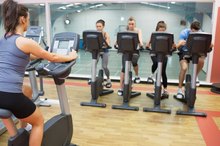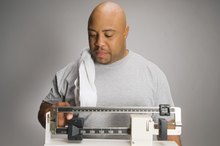What does fact checked mean?
At Healthfully, we strive to deliver objective content that is accurate and up-to-date. Our team periodically reviews articles in order to ensure content quality. The sources cited below consist of evidence from peer-reviewed journals, prominent medical organizations, academic associations, and government data.
The information contained on this site is for informational purposes only, and should not be used as a substitute for the advice of a professional health care provider. Please check with the appropriate physician regarding health questions and concerns. Although we strive to deliver accurate and up-to-date information, no guarantee to that effect is made.
How Many Strides Per Minute on the Elliptical?
Increasing or decreasing your strides-per-minute rate while on an elliptical machine will directly affect your workout intensity. Exercising at the appropriate intensity is essential to receiving the numerous health benefits that come from regular cardiovascular exercise. The appropriate strides-per-minute rate varies among individuals.
Benefits of Elliptical Machine
Consistently working out on an elliptical machine provides numerous health benefits, including burning calories to promote and support a healthy body fat percentage, as well as lowering the risk of stroke, hypertension and heart disease. According to Harvard Health, a 155-pound person will burn about 670 calories for every 60-minute elliptical machine workout 1.
Importance of Intensity
Important Qualities of a Good Roommate
Learn More
Exercising at the appropriate intensity is crucial to burning calories and developing cardiovascular health. If you are working out at too low an intensity, you won’t burn as many calories during your session and you won’t adequately stimulate your heart so that it develops and increases in strength. Work out at too high of an intensity and you won’t be able to maintain your elliptical workout for long.
Monitoring Intensity
When you’re riding on an elliptical machine, you should either monitor your heart rate to be sure you’re within your target heart rate range, or use the talk test. Your target heart rate range is 65 to 85 percent of your maximum heart rate. Calculate your target heart rate by first subtracting 88 percent of your age from 206 to get your maximum heart rate. Then multiply that value by both 0.65 and 0.85 to find your target heart rate range. Once you find your target heart rate range, monitor your heart rate while on the elliptical machine and make adjustments to your workout intensity as necessary. The talk test requires you to monitor your breath while on the elliptical. You should be able to talk to another person, but be too out of breath to hold a continuous conversation.
- When you’re riding on an elliptical machine, you should either monitor your heart rate to be sure you’re within your target heart rate range, or use the talk test.
- Once you find your target heart rate range, monitor your heart rate while on the elliptical machine and make adjustments to your workout intensity as necessary.
How to Control Intensity
How Much Weight Is Lost Doing 20 Minutes on the Stair Stepper?
Learn More
You control your elliptical machine workout intensity by either adjusting your strides-per-minute rate or the resistance and incline on the pedals. The appropriate strides-per-minute rate for you is the rate that either places your heart rate within the target heart rate range or allows you to pass the talking test. You can pedal faster or slower to increase or decrease your workout intensity, respectively.
Related Articles
References
- Harvard Health Publications: Calories Burned in 30 Minutes for People of Three Different Weights
- The New York Times: Recalibrated Formula Eases Women's Workouts
- American Heart Association. Know your target heart. Updated June 2015.
- Edwards S. The Heart Rate Monitor Guidebook. Velo Press. 1999.
- American Heart Association. Know your target heart rates for exercise, losing weight and health. Updated June 2015.
- Harvard Medical School. Do you need to talk to a doctor before starting your exercise program?.
- Brookreson N. Using Heart Rate Monitoring for Personal Training. American College of Sports Medicine. https://certification.acsm.org/blog/2015/july/using-heart-rate-monitoring-for-personal-training.
Writer Bio
Kim Nunley has been screenwriting and working as an online health and fitness writer since 2005. She’s had multiple short screenplays produced and her feature scripts have placed at the Austin Film Festival. Prior to writing full-time, she worked as a strength coach, athletic coach and college instructor. She holds a master's degree in kinesiology from California State University, Fullerton.







